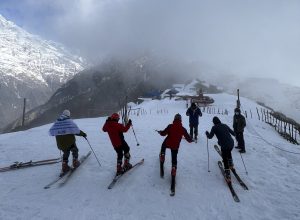
Nepal is synonymous with the Himalayas and its valleys. It has long been a destination for adventure enthusiasts with thousands of people coming to the country for trekking, camping and mountaineering. However, in the past few years, a distinctive trend has surfaced, combining the excitement of adventure with the breathtaking natural marvels of the region: honey hunting adventure tourism.
This trend has become so popular now due to the pursuit of mad honey. Hence, it has brought newfound economic opportunities to Nepal’s remote villages while captivating the hearts of daring tourists.
The Gurungs and the mystique of mad honey

The mighty honey hunters of the Gurung community are the ones who collect the mad honey from the high cliffs of Nepal. These honey hunters come from remote villages where they live in a wholesome community that has dedicated most of their lives to honey hunting.
This age-old practice has been passed down from generation to generation and involves brave individuals journeying into the heart of the Himalayan wilderness. Although the youngsters of the community are opting to go abroad for a better life, they now see rays of hope in honey hunting.
It might take tons of dedication and physicality, but it is a sign of their ancestral pride that they still want to ignite in them.
Moreover, mad honey has a range of medicinal properties, including antibacterial and anti-inflammatory effects. Local healers and traditional medicine practitioners use it to treat various ailments, such as respiratory conditions, digestive issues, and even wounds.
Mad honey is often used as a natural analgesic. It alleviates pain and discomfort, making it especially valuable as a pain relief in areas where access to modern healthcare is limited.
Some communities view mad honey as an immunity booster. Regular consumption is thought to enhance the body’s ability to resist common illnesses. In certain cultures, mad honey is considered an aphrodisiac and is used to improve sexual vitality and performance.
Honey hunting and employment opportunities

You cannot deny but accept that one of the reasons mad honey became so enormously popular is due to its psychoactive properties. Travellers from around the world are drawn to Nepal to experience this unique honey and enjoy its thrilling experience.
The rise of mad honey tourism has not gone unnoticed by the international media. Documentaries, travel shows, and articles have showcased the adventures of honey hunters and the allure of mad honey. This media exposure has piqued the curiosity of travellers and adventure enthusiasts.
The honey-hunting adventure trend has led to a need for local guides who know a lot about the land, how bees act, and the old ways of hunting. There are also other people, like porters and cooks, who help make these trips happen. The good part is that all this activity creates jobs for people who live there.
They have this extra way to make money, and life has become better for lots of families in faraway places. They do not have to worry as much about bad weather or crops not growing. It is like having a safety net that helps them live a good life.
Tradition of honey harvesting

The hunters prefer hunting mad honey in the spring and autumn seasons because that is when the giant honeybees are most active.
During the spring season (March to May), as temperatures rise and flowers bloom, the bees become highly active in search of nectar. This time of year marks the beginning of the honey-hunting season.
The bees, fueled by blooming rhododendrons and other wildflowers, start to build their hives, making it an ideal time for hunters to collect honeycombs.
Likewise, in the autumn months (September to November), after a summer of collecting nectar and producing honey, the bees prepare for the winter season. This period presents another opportunity for honey hunters to collect the mad honey before the onset of winter.
On the spot, before they dive into the actual process of honey hunting, they host a puja (religious activity) dedicated to their bee guardian spirit, Rangkemi. They believe that the guardian bee spirit helps them during the hunt by providing courage.
They host the ceremony by sacrificing chickens and offering fruits and alcohol to their deity. They also dance in the chantings that are only known to them, in a gypsy way. The ceremony is unique and unusual, showing how they interconnect spirituality with their work.

The honey hunters go through the following steps to actually perform the honey hunting harvesting:
- Climbing steep cliffs: The first step in honey harvesting is scaling steep cliffs and rocky slopes. These rocky areas are usually found in some of Earth’s most rugged and hard-to-reach places. Honeybees, especially the Apisdorsata laboriosa, build their hives in these high and challenging locations to keep them safe from predators and the weather.
- Reaching the hidden hives: Once hunters reach these dangerous-looking hive locations, the real adventure begins. These hives are in hidden cracks and crevices. To access them, honey hunters use various traditional tools and techniques that require great courage and skill. They use bamboo ladders, which they craft carefully for themselves. These ladders are strong but lightweight, allowing hunters to reach the hives while causing minimal harm to the environment.
- Distracting giant honeybees: Once they reach the hives, they are often welcomed with bee stings. The giant honeybees are brutal and do not stand for strangers trespassing on their homes. Therefore, the honey hunters come up with a plan to avoid them and calm them. They burn the grass to distract them so that they can go on with their plan to collect honey. In such a practice, there’s no harm to the bees since smouldering grass only pacifies their aggression.
- Collecting mad honey with ropes and baskets: Besides bamboo ladders, ropes and baskets are crucial for honey harvesting. Ropes secure the ladders to cliffs that provide safety during the hunt. The baskets are woven from bamboo or local materials. You can not only observe a great deal of physical strength in honey hunters but also find a deep understanding of bee behaviour.
Capitalise now
The possibilities of adventure tourism through honey hunting are high. Moreover, there should be efforts to conserve and sustain honey hunting to promote adventure tourism in Nepal. Along with that, it is very important to find a balance between adventure tourism and taking care of our environment.
If Nepal is able to promote this adventure tourism, tourists who visit Nepal can become partners in the effort to protect Nepal’s amazing landscapes and its rich traditions. By respecting the land and the people, tourists help make sure Nepal’s natural wonders are still here for our kids and grandkids to see and enjoy.


















